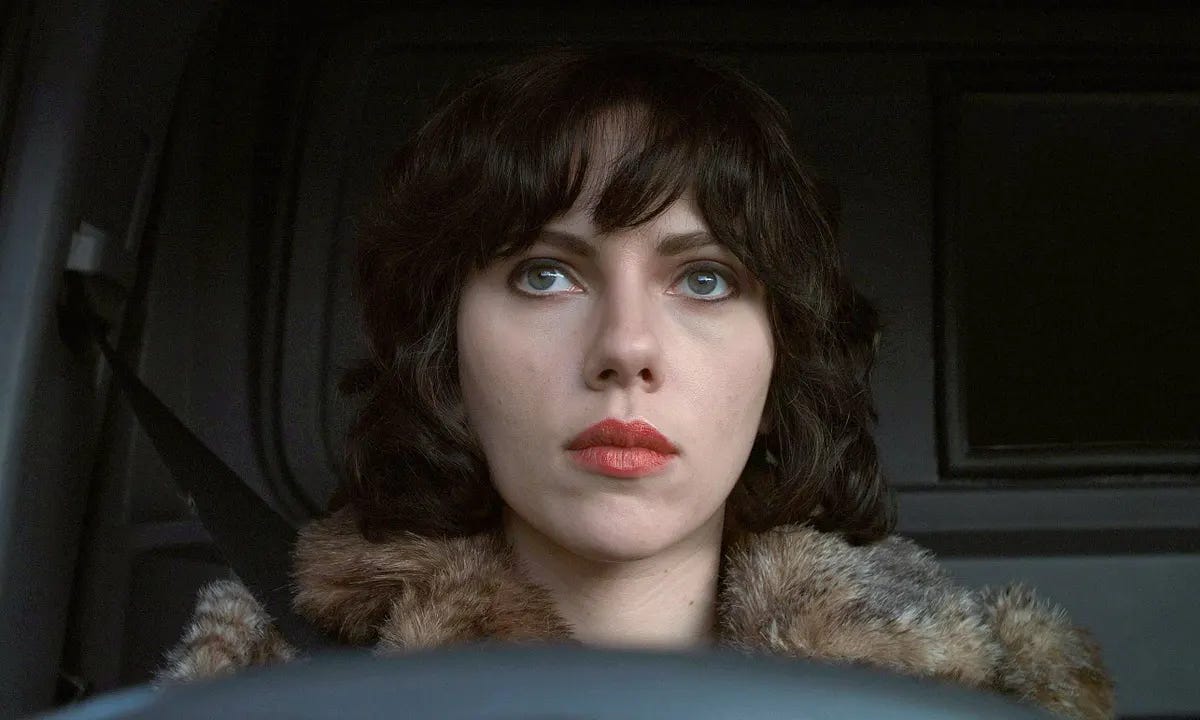The New Cult Canon: 'Under the Skin'
Jonathan Glazer's radical, stripped-down science fiction film follows an alien changed by her contact with humanity.
“You’ve very nice hands. You’ve beautiful hands.” — Scarlett Johansson, Under the Skin
Michel Faber’s 2000 novel Under the Skin is about Isserley, an extraterrestrial sent to Scotland in the surgically altered form of a human woman, a disguise she uses to kidnap hitchhikers, who are then delivered to her fellow aliens. Back home, humans are fattened and processed into an expensive delicacy known as “Vodsels”—a name inspired by the Dutch word for “food.” Faber’s book is a satire of factory farming, immigration, and the darker aspects of civilization, told from Isserley’s unique perspective. The screen adaptation, directed by Jonathan Glazer from a script he wrote with Walter Campbell, is about almost none of that. Here’s how Glazer put it when I asked him about what he decided to keep and discard from the book:
The writer who wrote the screenplay [Walter Campbell] that we basically went off to shoot with hadn’t read the book at all. In fact, he didn’t want to read the book, and I thought that was a really good move. The book had almost left my consciousness, so we started with no knowledge of it. Still, the central things in the book are in the film. Not dramatically, but spiritually there’s a fundamental thing that holds the film and the book up the same.
He continues:
The political component to the book was to do with eating meat, and it was a satire on corporate greed and crime. It was quite interesting, and I enjoyed reading it, but that wasn’t the part that resonated with me at all. The part that resonated with me was this idea of seeing things with her, experiencing things with her, having her see things for the first time.
It may sound disrespectful to praise the screenwriter for not wanting to read the book, but Under the Skin is a prime example of why fidelity to a novel is a neutral virtue at best, if not a potential pitfall. Too many adaptations are acts of illustration, picking out elements that either don’t translate readily to film or need to be cut for efficiency’s sake. Not enough filmmakers have the courage—or the temerity, really—to extract what they see as the essence of the material and leave the rest behind. Glazer may have conceived Under the Skin as a “spiritual” companion to Faber’s novel, but he understands film and book to be separate entities. he result is a haunting work of science fiction that confounds and challenges its audience, stripping away so much information that all we’re left with are questions, mostly answered by suggestion.
In fact, that little bit of jacket description would put a viewer far ahead of someone encountering Under the Skin cold, because it’s not immediately clear what Scarlett Johansson’s alien is doing—or, indeed, if she’s an alien at all. The opening sequence feels like the most overtly Kubrickian in the film, starting with a black screen and a pinspot of light that expands slowly as the mad strings of Mica Levi’s score undulate on the soundtrack. It is a human eye under construction, but Glazer makes it look like a solar system, with a single light source reflecting against multiple circular components. Perhaps it’s obvious to some that the eye is artificial, but the 2001 connection makes it seem elemental, like the Big Bang moment that sets this universe into motion.
From there, Glazer cuts to the image of a motorcyclist zipping through a winding oceanfront roadway at night, pulling over at a shoulder, disappearing into the darkness toward the water, and emerging with a dead woman’s body slung over his shoulder. The body goes into a van whose interior glows with white light, the sort of abstraction that Glazer uses to suggest the supernatural. Inside the van, the naked, unnamed being played by Johansson raids the body for come-hither clothing—a pair of ripped fishnet stockings, a mini-skirt, and high heels—that she’ll complete with a faux-fur coat. To the extent that she understands humans at all at this point, she knows that men will be aroused by her. That is all she needs to know.
Many of the interactions between the alien and the young men she tries to lure into the van are improvised on the streets of Glasgow, with Johansson talking to them through her driver’s side window as a small digital camera captures the action. The accumulation of these scenes, along with other caught footage of Glaswegians going about their everyday lives, have an inevitable humanizing effect while also placing this alien firmly in the world as we know it. There are sequences in Under the Skin that are robustly stylized, like the ritualistic episodes where the alien starts removing her clothing in a reflective black space that becomes a kind of sinking tar as her victims walk through it. And there are sequences that showcase the bleak beauty of the Scottish countryside, with the sea carving dramatically into the hills and mountains, and overhead shots of pine trees swaying like wheat in the harsh wind. But these documentary-like scenes in Glasgow give the film a varied visual texture, and keep it grounded in reality.
Without getting into the particulars, the alien’s mission here is to hunt men whose bodies are then crushed and processed, though Glazer only gets far enough in the latter process to note a flow of blood and guts through a sluice. What matters to him is how being on Earth changes her, which brings Under the Skin in line with Nicolas Roeg’s The Man Who Fell to Earth, another semi-experimental science fiction film about an alien sent to harvest resources but fatally affected by human interaction. Here, as in the earlier film, the impact is ultimately corrosive and tragic for the visitor, but both learn something about people (and themselves), too, that clouds their goals.
Two extraordinary bookend sequences stand out as the signposts for the alien’s development: The first is a beach scene where Johansson targets a swimmer in a wetsuit from the Czech Republic, but winds up witnessing a horrific event while she waits, as a mother goes after a dog that’s been swept out to sea and her husband, fully clothed, dives into the water after she gets in trouble, too. The swimmer tries to rescue the husband at a minimum, but Johansson clocks him swiftly on the head with a rock, not unlike a cattle rancher with a bolt gun. A baby is left screaming and crying on the beach without its parents, and we learn later, through a radio report, that the entire family has been found dead.
Much later in the film, Johansson picks up a 26-year-old man (Adam Pearson) with a facial deformity who’s on his way to a grocery store at night, because it’s less crowded and will limit the likelihood of people winding him up. She compliments his hands and offers him the experience of touching her face and neck—experiences that he has never had before. She’s not repulsed by him—humans would recoil at her, too, if they could see her true face—and she extends a sympathy and kindness to him that later turns into mercy. How could an alien not identify with alienation? She cannot continue in her mission any longer, and she starts on a path that leads to oblivion.
Under the Skin is about the actor becoming the part she’s been playing without entirely being able to fill out the role. In the brief, terrifying stretch where Johansson’s alien becomes human, she discovers that she cannot eat a simple piece of chocolate cake and cannot make love to a stranger who has shown her surprising tenderness. She also learns that, like many women, she’s vulnerable to the abuses of predatory men, like a logger whose violent rape attempt turns out to be the last impression anyone will make on her. It would be possible to re-edit Under the Skin into a film that isn’t about an alien at all, but a harrowing drama about a woman’s efforts to seek sexual gratification in a world of masculine peril.
Critics loved Under the Skin at the time—it was #3 on our collective “Best Films of 2014” list at The Dissolve in 2014—but the public response was inevitably more polarizing, which is the sort of dynamic that secures future cult status. But Glazer’s film feels like a stripped-down companion to The Man Who Fell to Earth, each radically reorienting our perspective to that of a visitor from another planet, seeing our world with fresh eyes. Johansson’s alien doesn’t have the sensitivities inherent to Bowie’s alien in the earlier film, but she acquires them, which is a credit to humankind, even if the overall picture is despairing. We may not be fit for the slaughter, but we’re not redeemed, either.
Next: The Empty Man






I've never been that impressed by ScarJo, to be honest. The Girl with the Pearl Earring, for example...I thought she was borderline terrible in that film.
But this one...for me, it's her best performance. Career performance. Not sure why she connected so seamlessly to the material, but so glad that she did. It's such a heartbreaking role. It's been a while since I saw this, but I think there's a scene near the end where she's driving her car and crying from all the loneliness and pain and I can still remember feeling every bit of her alien sadness.
It's really something that I can still remember those scenes where the men she traps sink into the black goo. Zero gore, yet terrifying, because it's so damn mysterious. What a movie.
Glad to see this in October, because the beach scene and the peek at the process below the goo hit me harder than most traditional horror. After the two floating victims hold hands, there's a cut to a wide shot of the person further along in the process, briefly floating away before popping and deflating. That popping sound made me jump the first time. In the many viewings since then, I swear the time between the cut and the pop gets longer each time, so it still gets me. Always having the sound turned way up contributes too, but it's a must to enjoy one of my favorite scores of all time.